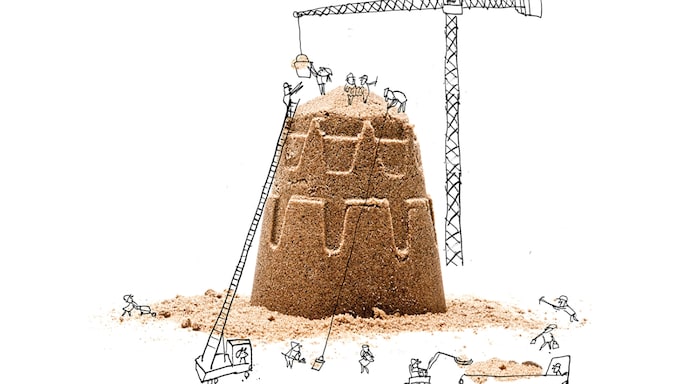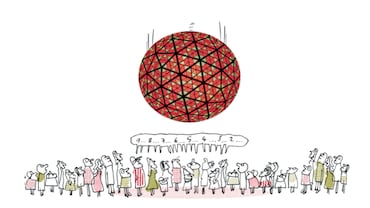- HOME
- /
- Odds and Ends
- /
- Who knew
- /
13 Nitty-Gritty Details on Sand
Can you eat sand? How much of sand is actually poop? Is stealing sand a crime?
 Illustration by Serge Bloch: Fuse/Getty Images
Illustration by Serge Bloch: Fuse/Getty Images
1
You might think sand is beige—and boring. But sand comes in every colour. The black sand in Hawaii and Santorini has volcanic minerals mixed into it. Bermuda’s pink beaches get their colour from the red and pink shells of tiny marine creatures. Even rarer is green sand, whose colour comes from the mineral olivine; only a handful of beaches have enough of it to appear distinctly green. And on Rainbow Beach in Australia, the sand appears in more than 70 colours.
2
Sand can taste good. We think of it as the blanket covering a beach, but technically sand is any material made up of grains measuring six one-hundredths of a millimetre to two millimetres in diameter. With that definition, salt and sugar qualify.
3
The material we commonly think of as sand is silica—made up of quartz crystals that have broken down naturally. However, sand can form in the opposite way too: Tiny particles can get coated over in waters with high levels of calcium carbonate or other minerals, creating a special kind of sand grain called an oolith.
4
The stuff on the shores can come from a variety of sources, including from the poop of parrotfish, which eat algae and dead coral and excrete hundreds of pounds of sand a year. Sound gross? Perhaps, but the sand that comes out of parrotfish is what you’ll find on some of Hawaii’s most beautiful white sand beaches.
5
Still, most sand comes from granulated rocks that streams carry to the sea—some three billion tons of it each year. Yet we use 50 billion tons of sand around the world annually, to make paper, paint and the silicon chips that power computers. It’s also in construction materials such as concrete, brick and glass.
6
Depending on what’s in it, sand must be heated to more than 2,500°F [1,370°C] to become glass. The oldest (and fastest) glassmaker is lightning. When a bolt strikes dry sand, it instantly melts and fuses the sand into hollow branching glass tubes.
7
Not all sand is suitable for building. Desert sand is too smooth for the grains to lock together. Saudi Arabia, with all of its desert, has to import sand in order to build its cities. With much of the world urbanizing, the demand for sand has skyrocketed. Sand extraction is a billion-dollar industry worldwide.
8
People steal sand; there’s even a sand mafia in India. It’s illegal to take sand from any beach in Hawaii, though many tourists still do. Swiping sand from the Italian island of Sardinia could land you in jail.
9
When you lie on the beach, you’re lounging on someone’s living room. Most of the creatures who call sand home are microscopic. There are as many as a million of them in just a square metre of sand, though altogether they weigh less than a 10th of an ounce [that’s 0.28 gm]. On the other end of the spectrum, larger animals such as sea turtles lay their eggs in sand. Not all of them hatch, and those that don’t hatch provide nutrients for the plant life that grows in the dunes.
10
Sand—on a dune, in the desert or at the beach—can shift quickly. Sandbars are especially dangerous. They can be submerged in a matter of minutes, and riptides often form in breaks in the bar. Quicksand is not nearly as deadly as movies might have you believe. If you do find yourself stuck, lean back to distribute your weight over a larger area.
11
The world’s tallest sandcastle was built in 2019 at the annual sand sculpting festival held in Binz, Germany, a city on the island of Rügen in the Baltic Sea. It took a team of 20 almost a month to construct. The highest peak was nearly 58 feet high.
12
The German writer E. T. A. Hoffmann’s 1816 short story Der Sandmann popularized the myth about a creature who sprinkles sand in our eyes while we sleep. One version of this folktale is that the sand induces sweet dreams, hence the lyrics of the Chordettes song: ‘Mr Sandman, bring me a dream ...’
13
Carl Sagan said there are more stars in the universe than grains of sand on the world’s beaches. Of course, neither can be literally counted. But researchers at the University of Hawaii estimated the number of grains of sand on earth. Their answer: seven and a half quintillion. (That’s 75 followed by 17 zeros.)






